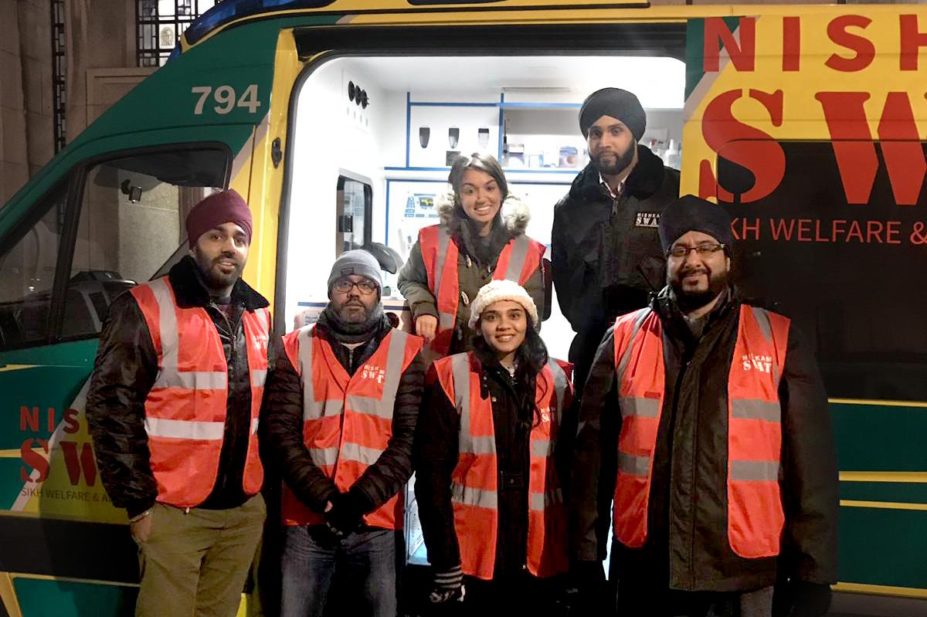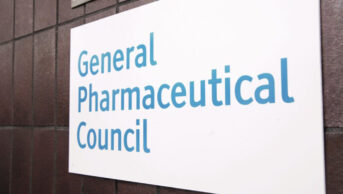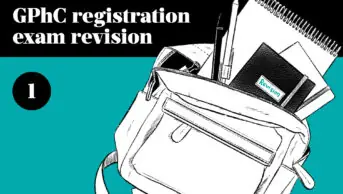
Daly Virdee
It’s 7pm on a Thursday evening in London, and just a stone’s throw from the five-star Savoy Hotel, a queue is forming on the Strand. But these people are not here for the latest restaurant opening or theatre production; they are a small handful of the UK’s growing homeless population, standing in line to receive aid to see them through the night.
When Queen’s Award winning charity, the Nishkam Sikh Welfare and Awareness Team (SWAT), started out in 2009, it was to take the concept of ‘Langar’ — a Sikh word for a community kitchen where a free meal is served to all visitors, regardless of faith, gender or ethnicity — out onto the streets. However, over time it became clear that for those who congregated around the SWAT van, food and warm clothes were not enough; there was also a demand for medical attention.
The organisation invested in an ambulance and Daljinder Virdee, a military pharmacist, was entrusted with the job of leading its team of healthcare professionals to provide aid to the homeless.
Virdee cuts a striking figure in camouflage trousers, a black bomber jacket with the letters S-W-A-T across the back, and a turban that, he says, has become a recognised symbol of the organisation. He was inspired to join NishkamSWAT after it invited the army to come and serve food to the homeless one afternoon.
All of the volunteers for the healthcare side of NishkamSWAT have full-time jobs, in GP practices, hospitals, community pharmacies and dentistry clinics
As a registered charity, NishkamSWAT is completely reliant on donations and has a budget of £100-£200 to buy medicines each month.
As we move through the queue handing out hygiene kits, donated by members of the public, Virdee explains that ‘Nishkam’ refers to an act of pure selflessness; all of the volunteers for the healthcare side of NishkamSWAT have full-time jobs, in GP practices, hospitals, community pharmacies and dentistry clinics.
The healthcare team was established in 2017, when a group of pharmacists began to provide the influenza vaccine to eligible at-risk people living on the streets of London — although they no longer provide this owing to restrictions under the patient group direction. For the past year, the group has been providing weekly services in London and Slough, Berkshire.
As well as hygiene kits — which include toothpaste, a toothbrush, wipes, sanitary items and cotton buds — the team of pharmacists, nurses, dentists and doctors provide minor ailment treatments and dental care, using a formulary of general sales list products, and offer advice to help alleviate symptoms.
The ambulance is stocked with paracetamol and ibuprofen for pain relief, and creams for fungal infections. On the occasions where the team runs out of medicines, it can replenish stocks from the Superdrug across the road, with which NishkamSWAT has a partnership. The volunteers steer clear of any invasive procedures, such as tooth removal, and instead refer to nearby NHS medical and dental clinics when faced with red flag symptoms, or provide first aid when necessary.
The issue of homelessness
Homelessness is a pertinent problem in the UK, which has been highlighted further during the COVID-19 pandemic. A study published in 2019 showed that nearly twice as many people were sleeping rough on any given night in England than in 2010[1]
. Figures published by the charity Shelter at the end of 2019 revealed that more than 280,000 people were recorded as being homeless in England on any given night, and 4,677 of these were sleeping rough[2]
.
The government has pledged more than £100m of funding to support rough sleepers and those at risk of homelessness during the pandemic, with the aim of avoiding concentrated outbreaks of the disease; almost half of rough sleepers are clinically vulnerable to COVID-19[3]
.
The homeless population have a high death rate, with an average life expectancy of just 45 years for men and 43 years for women, largely owing to opioid overdoses, accidents, heart failure and infectious diseases[4]
. However, those who sleep rough face a range of barriers to accessing the health and care system, including low literacy skills, lack of transportation or the difficulty associated with registering at a GP or dentist without a home address[4]
.
In addition, discrimination against the homeless community permeates through the healthcare system, leading individuals to be turned away in their moment of need. A qualitative study carried out by researchers at the University of Birmingham revealed reports of homeless people being denied registration at general practices and being discharged from hospital onto the streets with no access or referral to primary care providers[5]
.
The purpose of organisations like NishkamSWAT is to bridge the gap between the homeless and the NHS
“I personally dealt with a homeless man who was attacked and left with a broken leg,” recalls Virdee.
“He was discharged from hospital onto the streets without medication.
“He had on him a discharge letter, which I was able to use to obtain his prescription drugs and purchased them for him as an emergency supply from a local pharmacy.”
The purpose of organisations like NishkamSWAT, says Virdee, is to “bridge the gap between the homeless and the NHS”. Without the care that NishkamSWAT provides, many would end up in A&E.
In Scotland, pharmacists are bridging this gap through an outreach team of non-medical prescribers. Glasgow has had a problem with homelessness for “a long time”, says Richard Lowrie, lead pharmacist for research and development, and clinical pharmacist for the homeless health service at NHS Greater Glasgow and Clyde.
Lowrie started out his work with the homeless in a voluntary capacity, before beginning work as a clinical pharmacist at the Hunter Street Homeless Service in Glasgow, which offers healthcare services specifically to meet the needs of those living on the streets. Within the homeless service is the PHOENIx (Pharmacy Homeless Outreach Engagement Non-medical Independent prescriber Rx) team, which offers ‘assertive outreach’ (see Case Study).
Case study
History:
- Male, aged 42 years
- Sleeping rough for two years
- More than ten years of intravenous drug misuse of heroin and cocaine; chronic venous leg ulcers; persistent tachycardia of unknown aetiology; and an oedematous swollen left leg
- Referred to the PHOENIx team following an emergency hospital admission for community-acquired pneumonia
Initial action by PHOENIx team:
- Observed continued symptoms of shortness of breath, general malaise and malnutrition
- Prescribed further course of antibiotics to those given in hospital to help resolve pneumonia
- Prescribed salbutamol inhaler and spacer device
- Prescribed prednisolone 40mg daily for 5 days to improve breathing
- Gave one week’s supply of Ensure Plus to aid nutrition and recovery
- Secured daily methadone prescription
First follow-up by PHOENIx team:
- Patient admitted to hospital with cocaine-induced cardiomyopathy; started on five new medicines and discharged to a drug rehabilitation centre
- PHOENIx team visited the patient to explain each of the new medicines and undertake side effect checks
- After a week, the patient discharged himself. Continued efforts for engagement persisted and, following a discussion with the GP at the homeless practice, prescriptions continued in the short term
Second follow-up by PHOENIx team:
- Further hospital admission for a chest infection
- Patient requested help from the PHOENIx team at his new accommodation.
- The team examined him, reissued a prescription for each of his medicines at optimal doses, provided dressings for a leg ulcer and organised for him to be restarted on a methadone programme
Outcome:
- Patient remains alive, hard to reach, but engaged in treatment
- Strong trusting relationship between the patient and PHOENIx team.
Lowrie has run several bids for funding to increase the capacity of the PHOENIx team over the years. With that funding, pharmacists in Edinburgh, as well as Glasgow, are now carrying out outreach visits in partnership with homeless charities, including Simon Community Scotland, Streetwork and the Marie Trust. Through this service the pharmacists offer a full health assessment and then, if needed, provide treatment or refer on to another service. At the same time, the accompanying charity workers assess the social prescribing needs of the individual in terms of housing or benefits.
We can provide a more comprehensive package for patients because their needs are complex and multiple
“The idea is that, together, we can provide a more comprehensive package for patients because their needs are complex and multiple,” says Lowrie.
The team also works closely with hospital staff in Glasgow to target individuals who frequently attend A&E and address their healthcare needs, to prevent return and increase uptake of services in primary care.
A moving target
There are many challenges with this vulnerable population, since few stay in one place for long and it can be difficult to follow them up to see if their condition has improved. To help manage this, Lowrie explains, connections are essential.
“The Simon Community and Streetwork team who go out onto the streets have good knowledge of the whereabouts of folk — they’ll have a good idea as to whether they’re in jail or they’ve moved away. We also link in well with the hospital staff. We have electronic access to hospital records so that we know whether a person has been admitted.”
It’s the patient’s choice whether they want to accept our support
The Hunter Street Homeless practice also acts as a base for patients to visit of their own accord, although some will often appear one day and disappear the next.
“At the end of the day, it’s the patient’s choice whether they want to accept our support. Our approach is flexible: to try and follow up, offer support and keep putting it on the table for them,” says Lowrie.
To be able to help a homeless individual at all, however, it is important for there to be existing collaboration between the different health and care services — because there may only be one chance.
“You can’t say ‘Somebody else will look at that, they’ll be in touch in two weeks’, because that’s too late. You have to respond rapidly to be able to address everything the patient needs, while the patient is there,” he says.
Not for the faint-hearted
The issues that are presented to us are, quite literally, from head to toe
Helping the homeless is “not for the faint-hearted” says Lowrie. “[It’s] important that you’re able to empathise and support people unconditionally to try and get them into a better situation.”
Virdee believes that pharmacists are well suited to helping the homeless because of their knowledge base and varied skill set.
“The issues that are presented to us are, quite literally, from head to toe,” he says.
“[Pharmacists] really are the go-to people. They not only have the ability to diagnose, they have the ability to give treatment and advice as well.”
However, not all pharmacists will feel confident in dealing with this underserved group in the most effective way.
While evaluating the new medicines service, Asam Latif, a senior research fellow at the School of Health Sciences at the University of Nottingham and a pharmacist by background, came to the realisation that these pharmacy services were not reaching marginalised groups.
In an attempt to rectify this, Latif and others co-developed an e-learning resource, funded by the National Institute for Health Research (NIHR), to help improve pharmacists’ and other healthcare professionals’ knowledge of underserved populations, including the homeless[6]
.
The resource — which is freely available online — is designed to enable healthcare professionals to reflect on how they identify and approach these patients and the health challenges they face, and give them confidence when they do encounter individuals from those groups, so that they can engage and interact with them in the most effective way.
A qualitative evaluation of the resource for pharmacy professionals in England found that it successfully increased awareness and motivation to engage with marginalised groups, but also revealed the structural barriers that often hinder translation of this into everyday practice[7]
.
“If you try to talk to [pharmacists] about this they’ll turn around and say: ‘We’ve got these government cuts, we’re already short-staffed, it’s very difficult to do anything additional to what we’re doing’,” says Latif.
“It’s almost a wicked problem; at the moment, there’s no professional leadership, there’s no political leadership to drive this forward. And I think that’s quite sad considering what the consequences are.”
Working together
Latif says that, although organisations like the NIHR have taken steps to prioritise inequalities in health, care for marginalised groups, such as the homeless population, is still an under-researched area.
“If you don’t do the research in this group, we’re not going to get that evidence base in order to effect change and improve care for them,” he adds.
Lowrie is keen to link in with other organisations, like NishkamSWAT, that are carrying out similar work with the homeless population, but agrees that an evidence base needs to be created “so that it doesn’t just depend on enthusiastic individuals — [the service] is there because of its merit and because of the impact on patients”.
And that impact is clear.
A recent qualitative evaluation of the PHOENIx team’s work suggests it provides a “critical bridge” to primary and secondary healthcare for homeless people, who describe the service in overwhelmingly positive terms[8]
.
I’ve been involved in many cases where we’ve prevented A&E admissions, and through simple interventions we’ve put a smile on people’s faces all the way through to closing wounds and protecting life
Virdee also notes the positive effects of his organisation: “Personally, I’ve been involved in many cases where we’ve prevented A&E admissions, and through the simple interventions we’ve put a smile on people’s faces all the way through to closing wounds and protecting life.”
NishkamSWAT is now planning to grow a database of healthcare professionals and open up the healthcare aspect of their service in more locations across the UK.
“The food service is well established in 25 locations around the UK — we’d like to match that [number],” says Virdee.
The organisation is also trying to work with local clinical commissioning groups to enable the service to work within the existing structure of the NHS.
“We’re not trying to work against it,” says Virdee.
“We feel we could be the middle people to help send patients to the right NHS services, which have the proper indemnities and processes in place to deal with these conditions easily.”
As we are speaking, Virdee rushes over to attend to a man who is leaning on a bike rack, unable to stand unaided. At first, he appears to be in pain, but it soon becomes clear that he is having an adverse reaction to something he has taken — “probably Spice,” says Virdee.
Virdee sits the man down and offers him food and water, and, slowly, he becomes more alert.
As we move away, it becomes apparent that without that small, and relatively simple, act of kindness, the man may not have survived the night.
These types of actions continue throughout the evening; the team provides cream, warm socks and insoles to a man with a fungal foot infection, medicine to someone with a chesty cough, and advice to a woman with a rotten tooth.
At 9pm, Virdee and his team pack up and head home.
References
[1] Paudyal V, Gibson Smith K, MacLure K et al . Int J Clin Pharm 2019; 41:215–227. doi: 10.1007/s11096-019-00789-4
[2] Shelter. 2019. Available at: https://england.shelter.org.uk/media/press_releases/articles/280,000_people_in_england_are_homeless,_with_thousands_more_at_risk (accessed August 2020)
[3] Kirby T. Lancet Respir Med 2020;8(5):447–449. doi: 10.1016/S2213-2600(20)30160-0
[4] The King’s Fund. 2020. Available at: https://www.kingsfund.org.uk/sites/default/files/2020-02/Delivering-health-care-people-sleep-rough.pdf (accessed August 2020)
[5] Gunner E, Chandan S, Marwick S et al. Br J Gen Prac 2019;69(685):e526-e536. doi: 10.3399/bjgp19X704633
[6] University of Nottingham. 2017. Available at: https://www.nottingham.ac.uk/helmopen/rlos/pharmacy/practice/under-served/ (accessed August 2020)
[7] Latif A, Waring J, Pollock K et al. Int J Equity Health 2019;18(1):151. doi: 10.1186/s12939-019-1069-0
[8] Johnsen S, Cuthill F & Blenkinsopp J. 2019. Available at: https://pureapps2.hw.ac.uk/ws/portalfiles/portal/24776643/Pharmacy_Evaluation_Final_Report.pdf (accessed August 2020)
You may also be interested in

Pharmacy regulator considers giving up legal authority to conduct covert investigations of pharmacists

More than 40% of people with ADHD waiting at least two years to access mental health service, study finds
